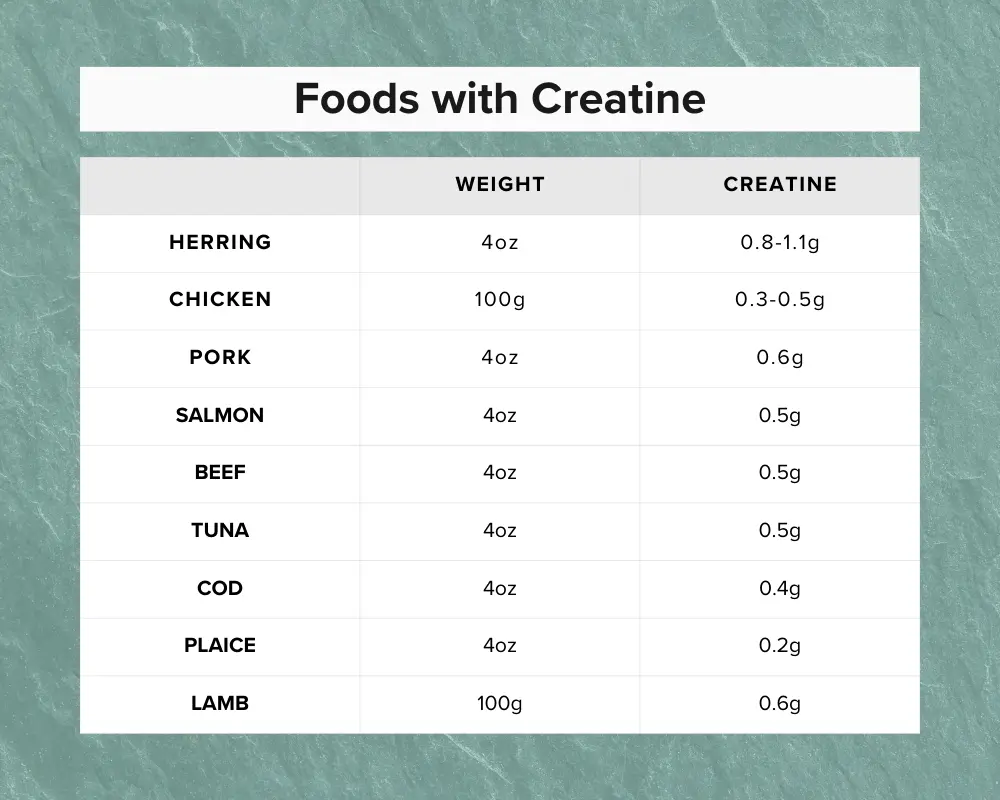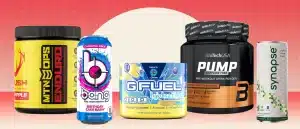9 Creatine-Rich Foods to Fuel Your Workouts
- By Rebekah Harding
- May 13, 2024
30-Second Takeaway:
- Eating up to five grams of creatine a day can support exercise performance, muscle recovery, and brain health.
- Animal-based foods like red meat, poultry, and fish have the highest creatine content.
- Vegans and vegetarians can support creatine needs with supplements and plant-based foods rich in amino acids.
Weekend warriors and pro athletes alike take creatine supplements to increase muscle strength and support recovery. But you might not need them if you eat enough foods with creatine.
The total amount of creatine your body can absorb from food and supplements is similar, according to a study in the Journal of Sports Sciences (1). But creatine from food maintains its peak longer.
Research shows that eating just five grams of creatine a day can help support your athletic performance and muscle recovery (2, 3).
Meat-lovers should find that goal easier to hit, since animal proteins like meat, poultry, and fish contain the most creatine. Plant-based eaters have to work a bit harder, but can lean on non-meat proteins like tofu to meet their goals.
About the Experts:
Lexi Moriarty, M.S., R.D.N., is a registered dietitian and founder of Fueled + Balanced Nutrition. She specializes in sports and performance dietetics.
Umo Callins, M.S., R.D.N., is a board-certified sports dietitian and fitness coach at Well Rooted Health and Nutrition.
Suzanna Thoe, R.D.N., is a registered dietitian with Fay, a nutrition counseling platform.
What Is Creatine?
Creatine is a compound made from three amino acids. It’s naturally found in meat and fish. Your body produces some on its own, too, by way of the pancreas, liver, and kidneys after you eat protein (3).
Your muscles convert creatine into phosphocreatine, which triggers the production of ATP, energy-carrying molecules (4) that give your body energy for short, explosive bouts of exercise says registered dietitian Lexi Moriarty, R.D.N. When you do sprint intervals on the track or engage in a grueling HIIT workout, for example, your ATP levels decrease (5).
Think about it like this: More creatine equals more ATP, which means more energy for your workout. And the harder you can push your body during exercise, the more muscle growth you can expect.
One study found that creatine supplementation improved training volume and anaerobic capacity in both power-driven (weight lifting) and cardio-based (sprinting) workouts (6).
It’s not just your muscles that benefit from creatine—you can take creatine to give your brain a boost, too.
While more research is needed, some studies indicate that taking creatine can improve short-term memory and cognitive function (7). The memory-boosting benefits of creatine may be particularly effective for older people (7).
Foods with Creatine
Creatine is mainly found in animal-based foods like red meat, poultry, and fish, according to Moriarty. But each type—and cut—of meat packs a different amount.

Cooking changes creatine content
How you cook these foods might also matter when it comes to boosting your body’s store of creatine (8).
“Cooking animal protein appears to increase creatine content, but there may be a temperature limit beyond which content decreases,” Umo Callins, R.D.N., says. The concentration may appear higher because muscle fibers contract when heated, which can slightly elevate its concentration of creatine (9).
Creatine is relatively heat resistant, but a study on lean beef shows that the compound begins to break down when cooked past 120 degrees Celsius (about 248 degrees Fahrenheit) (10). Granted, meat is practically charred by that point, so unless you’re into extremely chewy, burnt beef tips, you don’t have to worry about the grill torching the creatine content.
Notice that general food safety temperatures recommended by the United States Department of Agriculture (USDA) fall at least 100 degrees below that point of creatine breakdown. Generally, beef and fish are most safe when cooked to an internal temperature of at least 145 degrees Fahrenheit. For poultry, aim for 165 degrees Fahrenheit (11).
How much creatine to eat daily
If you eat a regular, omnivorous diet (which often adds up to be between 1-2 grams of creatine a day), your creatine stores are likely half full (2).
Getting an additional 2-4 grams of creatine a day through foods should keep them topped up. The exception: If you’re opting for a loading phase. In that case, aim for 25 grams a day for three to five days. These doses are typically broken up into 5g servings four to five times a day. (You’ll need a supplement for that.)
Unless you’re doing a full-blown carnivore diet—which many dietitians don’t recommend—you might struggle to get this amount of creatine through food alone. This is where a creatine supplement can help.
How To Get More Creatine Without Meat
Since creatine is highest in animal-based protein products, such as meat, poultry, and fish, it can be difficult for vegetarians and vegans to get enough creatine through diet alone. In fact, plant-based eaters often have lower amounts of creatine stored in their muscles, notes Suzanna Thoe, R.D.N. Low creatine levels can result in a loss of muscle mass over time (12).
Vegetarian and vegan-friendly foods with creatine include tofu and whole grains. However, these options only contain trace amounts compared to animal products. For example, 100 grams of tofu only contains 0.01 grams of creatine.
Luckily, there are a few tricks plant-based eaters can employ to support their body’s natural production of creatine—without compromising their diet—Callins and Moriarty say.
Take creatine supplements
The easiest way to up your creatine intake without eating animal products is to take a supplement, says Callins.
Non-meat-eaters should reach for creatine powders—not gummies or capsules. “When creatine comes in capsule form, it typically contains gelatin,” Callins says.
There are several different types of creatine, but creatine monohydrate is the most affordable, well-studied, and effective form (2).
Eat enough carbs
Research suggests noshing on carbohydrates while taking a creatine supplement helps with creatine retention (2). This is likely because carbs increase insulin levels which transfers not just glucose (sugar) from the carbs to your muscles’ cells, but creatine too (13). But once your muscle creatine stores are full, this effect stops.
In fact, one study found that consuming carbs and creatine at the same time resulted in 60 percent more muscle absorption of creatine (13).
Consume plenty of amino acids
Your body needs three amino acids to produce creatine: Arginine, glycine, and methionine (14). Upping your intake of pumpkin seeds, sesame seeds, walnuts, almonds, spinach, and spirulina (rich in all three amino acids) will help your body create creatine.
References
1. Harris, et al (2010). Absorption of creatine supplied as a drink, in meat or in solid form.
2. Kreider, et al (2017). International Society of Sports Nutrition position stand: safety and efficacy of creatine supplementation in exercise, sport, and medicine.
3. Antonio, et al (2021). Common questions and misconceptions about creatine supplementation: what does the scientific evidence really show?
4. Dunn, et al (2023). Physiology, Adenosine Triphosphate.
5. Hargreaves, et al (2020). Skeletal muscle energy metabolism during exercise.
6. Kreider, et al (2011). Creatine supplementation in exercise, sport, and medicine.
7. Prokopidis, et al (2023). Effects of creatine supplementation on memory in healthy individuals: a systematic review and meta-analysis of randomized controlled trials.
8. Elbir, et al (2021). Determination of creatine, creatinine, free amino acid and heterocyclic aromatic amine contents of plain beef and chicken juices.
9. Listrat, et al (2016). How Muscle Structure and Composition Influence Meat and Flesh Quality.
10. Bendall (2007). The effect of cooking on the creatine-creatinine, phosphorus, nitrogen and PH values of raw lean beef.
11. USDA. Safe Minimum Internal Temperature Chart.
12. Ostermann, et al (2016). The two sides of creatinine: both as bad as each other?
13. Theodorou, et al (2017). The effect of combined supplementation of carbohydrates and creatine on anaerobic performance.
14. Taegtmeyer, et al (2014). Creatine – A Dispensable Metabolite?












